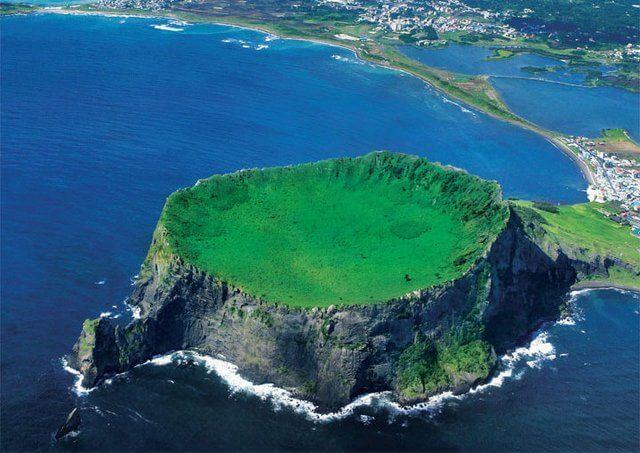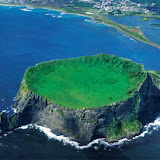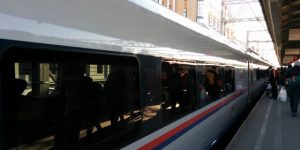
Seongsan Ilchulbong
Known as the ‘Island of the Gods’ by locals and ‘The Hawaii of Korea’ by the Korean Tourism board, Jeju Island is a little lava outcrop about 85km south of Korea. Jeju’s capital city is Jeju-Si and both are in the Jeju-do province, but despite the possibility for confusion we managed to fly the 40 minutes from Seoul to Jeju-Si airport and found our hotel which was the cheapest we could find on the island. Most resorts here are overpriced due to the captive market and popularity amongst honeymooning Koreans but we found a small hotel with mediocre reviews. On arrival it became apparent that the desk staff didn’t speak Korean, let alone English, Chinese, French, German, Spanish, Japanese or Russian so I went through the booking computer for them and found my reservation. They then handed over the key’s before I’d figured out how to switch my own room to a free sea-view suite without them noticing.
The rooms were small, but clean and like the rest of Korea had a remarkable internet connection speed. The air conditioning was feeble considering how hot it was outside so we went for a wander round Jeju-Si whilst it worked it’s magic. The town is quite compact and has a harbour surrounded by fish restaurants and an incongruous McDonalds, another street of Chinese and Japanese eateries and a street of clothes stores. As night fell we got peckish so wandered round trying to find some Korean food, which was easier said than done, but eventually found a run-down looking place that sold 3 versions of chicken: fried, boiled or stewed. We opted for the hotpot and a few minutes later a huge metal bowl of chicken stew emerged – it was cooked to perfection, delicious and embarrassingly cheap.
Back at the hotel the English speaking manager was present, so we took the opportunity to enquire after an English speaking tour guide taxi to drive us round the island the following day. They made a phone call and a few minutes later a chap called Kim Jin arrived to discuss our options. In extremely broken yet annoyingly pushy English he offered to drive us around for a day, which would cost more than his car was worth, so we politely declined.
Back at the hotel desk we tried again for just an English speaking taxi, but not a tour guide. They made a phone call and a few minutes later Kim Jin was back in front of us.
Underwhelmed, we gave up and just asked the desk for a Korean taxi as we had a list of the places we wanted to visit written in Korean and could just point to the relevant location.
—
The next morning weather was beautiful, the humidity wasn’t. Despite there not being a cloud in the sky it was difficult to tell whether it was raining or the humidity was just forming into the occasional lump and dropping out of the sky for a joke. Within minutes it looked like there had definitely been a rainstorm as my clothes were drenched and hair was flattened. Looking around, anyone that didn’t live on the island looked pretty much the same, even the honeymooning Koreans with their professional photographers in tow, trying to frame a shot before their subjects melted.
Our Korean-speaking driver appeared at exactly 9.00am, as requested, and despite our best efforts was Kim Jin again, looking a bit upset that we’d finally managed to get transport for a third of his original asking price.
I was keen to visit the underground and hopefully cool caves first, but our driver had decided our route and we didn’t get much say in matters, which is why in 40°C heat, 100% humidity and dressed for a chilly caving expedition we ended up climbing a volcano in the late morning sun.
 Seongsan Ilchulbong, or Sunrise Peak, is a famed round almost-island created by an eruption on the shallow sea-bed. Seen in most advertising for Jeju this is quite spectacular from the air (see right), so the 25 minute walk up seemed worth it, and there were plenty of other people making the effort. 600 steps later, and quite damp, we reached the top. There really is nothing to see from ground level apart from a few elderly gentlemen slumped over whilst their families fan them to try and revive them from near heart attack status.
Seongsan Ilchulbong, or Sunrise Peak, is a famed round almost-island created by an eruption on the shallow sea-bed. Seen in most advertising for Jeju this is quite spectacular from the air (see right), so the 25 minute walk up seemed worth it, and there were plenty of other people making the effort. 600 steps later, and quite damp, we reached the top. There really is nothing to see from ground level apart from a few elderly gentlemen slumped over whilst their families fan them to try and revive them from near heart attack status.
Back at the bottom we went to our driver’s next stop, Seonggeup Folk Village. This is a mud hut/straw roof type of village with tourists wandering round taking photos of everything, which suddenly becomes quite uncomfortable when you realise it’s not a museum, but people are actually going about their lives there. It wouldn’t be an issue to miss a visit, but if anyone does go, take a guide book (or hire a tour guide…) as there is no English signage or literature.
Back on the coast is the Haenyeo Museum. Aimed at Korean schoolchildren this is actually a really interesting story of the women divers who provide seafood and seaweed for the island. They dive to the sea bed without any gear apart from maybe a pair of goggles and a wetsuit and are legendary throughout Korea. They were instrumental in improving equality for women and minimum working conditions for all Koreans. (http://www.haenyeo.go.kr/)
As the sun lowered in the sky and the light became perfect for taking photos outside we reached the underground caves. Manjanggul is regarded as the finest lava tube system of caves anywhere in the world, with its multi-coloured carbonate roofs and floors, and dark-coloured lava walls. The first kilometre of the 13km cave system is open to the public and it can clearly be see how the tunnels acted as a natural conduit for erupting lava, even including lava stalagmites.
Our last stop was Dongmun Traditional Market, which pretty much just sold an endless variety of fish, rice and dish cloths, so I left the others to it and finally sat down with a cold drink until I was told off by our driver for getting the wrong flavour.
Still sore from the previous day’s exhertions we decided to just visit one site the next day so took a bus to Jusangjeolli. Here on the coast the erupting lava has cooled, cracked, fractioned and contracted to form cliffs and headlands of black hexagonal pillars similar to those of the Giant’s Causeway in County Antrim, Northern Island.
The area surrounding the cliffs is a nicely sculpted park full of mandarin orange trees, which along with pork from black-hair pigs and abalone (a type of shellfish with supposed aphrodisiac properties) are the most famous product of Jeju.
Also present in the park are the life-sized, helmet-wearing symbolic statues of the island, the dolharubang or “stone grandfather”. They represent the ancestors who throughout history endured the natural hardship of the islands terrain.
Next to the park are the International Convention Centre and the Jeju World Cup stadium, used when South Korea hosted the tournament in 2002. Handily from here there’s an airport shuttle bus which got us roughly back to Jeju City and the eventual relief of the hotel air conditioning, before our flight back to Seoul then Beijing early the next day.
P.S. Our lack of transport caused us to miss the very popular Teddy Bear Museum and Loveland, a very graphic museum of erotic statues, so was a bonus really. The only other attraction I’d really like to have taken part in was the submarine ride, a trip 40m below the waves to see the coral and possibly even a Haenyeo.





